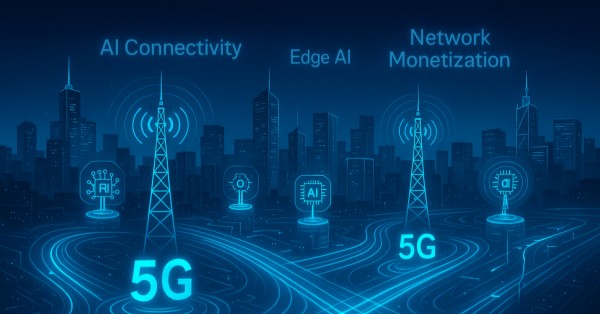Huawei Proposes AI-Centric F5.5G Network and “FOUR NEW” Strategy to Drive Growth in Digital Intelligence Era
At the 10th Ultra-Broadband Forum (UBBF 2024) in Istanbul, Huawei unveiled its ambitious plans for a fully AI-integrated F5.5G all-optical network, designed to support the growth of digital intelligence services and unlock new revenue for telecom carriers. Huawei executives Bob Chen and James Chen presented complementary visions that highlight how AI, paired with advanced fiber-optic networks, can transform the telecom industry, empowering carriers with fresh opportunities in network monetization, automation, and consumer services.
Huawei’s AI-Driven F5.5G Network: Redefining Connectivity and Carrier Services
Bob Chen, President of Huawei’s Optical Business Product Line, introduced the company’s strategy for creating an F5.5G all-optical network tailored to AI-driven applications. As AI applications gain traction across industries, Huawei aims to leverage F5.5G technology to support the increasing demands for high bandwidth, low latency, and reliable network infrastructure required for AI-centric computing. In his speech, Chen outlined how Huawei’s innovations in optical transmission and access technologies can enable telecom providers to build future-ready networks.
Huawei’s optical solutions are designed to bring high-speed, low-latency connections to data centers and metro networks. Huawei’s advanced optical switching technology enables data centers to scale from supporting thousands of AI computation cards to millions, using dense port configurations and energy-efficient setups. This “optical module-free” deployment model can reduce hardware failure rates by up to 20%, ensuring seamless and efficient AI processing. Furthermore, Huawei has collaborated with over 50 telecom carriers globally to extend optical switching to metro networks, creating latency zones as low as 1 millisecond (ms) for critical AI services.
Monetizing Premium Broadband Experiences with Huawei’s Fiber Innovations
In the realm of optical access, Huawei emphasizes the importance of high-quality, reliable broadband experiences, which can be monetized through various strategies. According to Chen, fixed broadband networks must deliver stable and guaranteed connections to ensure superior service. Huawei suggests three primary monetization approaches for carriers: coverage monetization, bandwidth monetization, and experience monetization.
- Coverage Monetization: As fiber connectivity is unavailable to nearly 28% of global users, Huawei’s QuickConnect ODN and all-scenario AirPON solutions provide fast, cost-effective ways to expand fiber access to these underserved areas.
- Bandwidth Monetization: Huawei advises carriers to upgrade their broadband packages incrementally. While many operators offer only basic broadband speeds, transitioning to higher-capacity services, such as gigabit packages, can attract more subscribers and enhance user experience.
- Experience Monetization: With Fiber-to-the-Room (FTTR) becoming the industry standard, carriers can ensure seamless, high-quality internet access across every corner of a household, forming the foundation for a smart home ecosystem. Huawei’s FTTR+X innovations facilitate AI-powered applications, including AI-driven storage, home security, and healthcare services, all managed within a single network.
Huawei’s management and control platform incorporates digital twin technology and AI-based models to streamline network operation and maintenance (O&M). These tools facilitate quick fault identification and real-time network adjustments, reducing customer complaints by 30% and cutting down service deployment times from months to hours.
Huawei’s “FOUR NEW” Strategy: Leveraging AI and Networks for New Revenue
James Chen, President of Huawei’s Carrier Business, introduced the FOUR NEW strategy, a framework to help carriers capture emerging business value in the AI and digital intelligence era. The strategy comprises New Hub, New Services, New Experience, and New Operation:
- New Hub: Huawei envisions the AI Hub as the center of smart home services, where intelligent AI agents interact with household members and IoT devices to meet diverse needs. This hub expands the boundaries of home-based AI applications, enhancing user engagement.
- New Services: AI enables carriers to offer advanced services such as interactive fitness, healthcare support, and educational applications within the home. These innovations not only improve lifestyle convenience but also establish a foundation for a thriving home AI ecosystem.
- New Experience: Services like cloud gaming, live e-commerce, and advanced media searches demand robust network performance. Huawei’s high-quality network solutions allow carriers to monetize based on service quality metrics like latency and bandwidth, opening avenues for experience-based revenue models.
- New Operation: As networks expand in size and complexity, AI-enabled autonomous operations become essential. Huawei’s L4 autonomous driving network reduces customer complaints and enhances service delivery by automating network maintenance, accelerating troubleshooting, and decreasing on-site visits.
Huawei’s Path Forward: AI-Integrated Networks for the Digital Intelligence Era
Huawei’s combined F5.5G network vision and FOUR NEW strategy showcase the company’s commitment to helping telecom carriers embrace the digital intelligence transformation. By integrating AI with high-capacity optical networks, Huawei aims to support carriers as they tap into the value of advanced AI applications, optimize operations, and deliver new services to consumers.
In the coming years, Huawei plans to work alongside carriers and industry partners to accelerate the adoption of AI-driven solutions, helping them achieve sustained growth and network efficiency. With AI integration in networking on the rise, Huawei’s strategy underscores the potential for a prosperous digital intelligence era powered by network and AI advancements, transforming everyday life and industry applications alike.






















